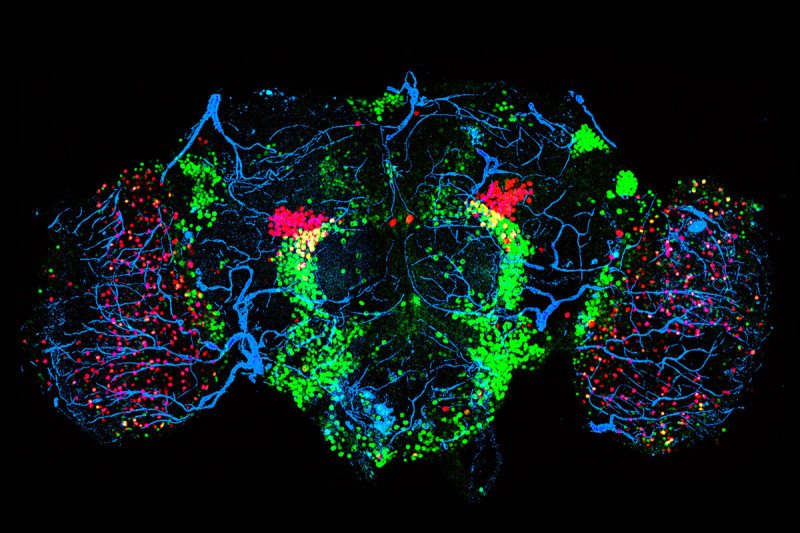
A female fruit fly brain as viewed through a confocal microscope. Credit: D. Garaulet
For many animals, sex is a major life event requiring a specific set of adaptive behaviors. Birds build nests. Mice become aggressive and territorial. Even fruit flies take sex seriously.
Particularly for a female fruit fly, mating comes with predictable changes in behavior.
“She’ll reject advances from additional males and then she will lay eggs,” says Daniel Garaulet, a postdoctoral fellow in Eric Lai’s lab at the Sloan Kettering Institute.
For a female fly, egg laying is energetically expensive, so it’s in her best interest not to do it unnecessarily. That means she must have an internal sense of when she’s pre- and post-sex.
“We call these the virgin and the post-mated states,” Dr. Garaulet says. “It turns out there are a whole series of behaviors that must be kept on pause until a female mates. But then once that occurs, they have to be switched on.”
How this switch operates, at molecular and neurobiological levels, has long been a mystery. But through a painstaking series of genetic experiments, Dr. Garaulet has uncovered new and surprising details about how it works. The results were reported in the journal Developmental Cell on June 23.
Sex on the Brain
Normally, the post-mating switch is thrown when a component of fly semen, called Sex Peptide, reaches receptors in a female’s uterus. This chemical connection sends a signal to the female’s brain through a long nerve that connects the two.
But as Drs. Garaulet and Lai discovered, female flies with a particular genetic mutation get confused and think they have mated when they haven’t. These mutant females lay eggs profusely and spurn the attention of males. It’s as if the switch has been flipped even though they haven’t actually had sex.
The mutation occurs in a region of the fruit fly genome called BX-C, which developmental biologists have been studying for decades. BX-C is perhaps more famous for containing protein-coding Hox genes that specify the body plan of a developing fly embryo.
Interestingly, the region of BX-C that controls mating behavior doesn’t make proteins, but instead produces microRNAs (miRNAs). These small molecules bind to genes and in so doing turn them off. One of the genes the BX-C miRNAs bind to is called homothorax (hth). In the BX-C-mutant flies, the miRNAs aren’t made, so hth is “de-repressed” — inadvertently turned on.
Dr. Garaulet showed that editing out the miRNA binding sites on the hth gene had the same effect as removing the miRNAs: the post-mating switch in the flies was flipped.
A Molecular Brain Circuit
The miRNA binding sites are located on a part of the gene’s messenger RNA called a 3 prime untranslated region (3’ UTR). This is the part of the messenger RNA that isn’t translated into protein, but can affect protein function. A 3’ UTR can be of variable length in different tissues. Dr. Lai’s research showed that in brain tissues, 3’ UTRs are often very long. The one on hth “goes on forever,” Dr. Garaulet says.
“We had been wondering: What are these good for? Why does the brain have so many genes that have this long untranslated region?”
This added length, he says, provides more opportunities for the hth gene to be precisely regulated in neurons.
Long 3’ UTRs aren’t limited to flies. “This is a pattern that is conserved from flies to humans,” Dr. Lai says. “This is one of the first concrete pieces of evidence that these neuro-UTRs play an important role in neural function,” he says. “We suspect there are many more, and that the fly is one of the best model organisms for studying these events.”
Dr. Garaulet adds that understanding more about how these 3’ UTRs regulate brain circuits could help scientists in their quest to understand neural diseases such as autism and schizophrenia.




